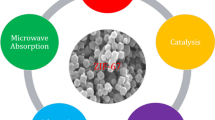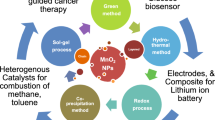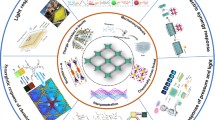Abstract—
In this work, nickel- and iron-modified aluminum-containing framework compounds—highly porous stable nanomaterials—have been prepared for the first time using magnetron sputtering, an environmentally friendly method. The materials have been characterized by a variety of physicochemical methods: BET measurements, atomic force microscopy, X-ray diffraction, thermogravimetric analysis, and IR spectroscopy. We have assessed the catalytic activity of the synthesized bimetallic framework compounds for the hydrogen peroxide oxidation of an azo dye. The results demonstrate that the addition of a small amount of these catalysts leads to an increase in reaction rate constant. The nickel- and iron-modified aluminum-containing framework compounds have been shown to retain their performance for at least four cycles (with allowance for regeneration via triple treatment with ethanol). A mechanism has been proposed for the hydrogen peroxide oxidation of the dye in the presence of the synthesized metal complexes, in which hydroxyl radicals act as an oxidizing species.










Similar content being viewed by others
REFERENCES
Glover, T.G. and Mu, B., Gas Adsorption in Metal-Organic Frameworks: Fundamentals and Applications, New York: CRC, 2018.
Tsivadze, A.Y., Aksyutin, O.E., Ishkov, A.G., et al., Metal-organic framework structures: adsorbents for natural gas storage, Russ. Chem. Rev., 2019, vol. 88, no. 9, pp. 925–978.https://doi.org/10.1070/RCR4873
Liu, J., Chen, L., Cui, H., Zhang, L., and Su, C.-Y., Applications of metal-organic frameworks in heterogeneous supramolecular catalysis, Chem. Soc. Rev., 2014, vol. 43, pp. 6011–6061.https://doi.org/10.1039/x0xx00000x
Wang, L., Zheng, M., and Xie, Z., Nanoscale metal-organic frameworks for drug delivery: a conventional platform with new promise, J. Mater. Chem. B, 2018, vol. 6, no. 5, pp. 707–717.https://doi.org/10.1039/C7TB02970E
Jiao, L., Seow, J.Y.R., Skinner, W.S., Wang, Z.U., and Jiang, H.-L., Metal-organic frameworks: structures and functional applications, Mater. Today, 2018, pp. 1–27.https://doi.org/10.1016/j.mattod.2018.10.038
Butova, V.V., Soldatov, M.A., Guda, A.A., and Lomachenko, K., Metal-organic frameworks: structure, properties, methods of synthesis and characterization, Russ. Chem. Rev., 2016, vol. 85, no. 3, pp. 280–307.https://doi.org/10.1070/RCR4554
Ertas, I.E., Gulcan, M., Bulut, A., Yurderi, M., and Zahmakiran, M., Metal-organic framework (MIL-101) stabilized ruthenium nanoparticles: highly efficient catalytic material in the phenol hydrogenation, Microporous Mesoporous Mater., 2016, vol. 226, pp. 94–103.https://doi.org/10.1016/j.micromeso.2015.12.048
Tanabe, K.K. and Cohen, S.M., Postsynthetic modification of metal-organic frameworks—a progress report, Chem. Soc. Rev., 2011, vol. 40, no. 2, pp. 498–519.https://doi.org/10.1039/c0cs00031k
Kou, W.-T., Yang, C.-X., and Yan, X.-P., Post-synthetic modification of metal-organic frameworks for chiral gas chromatography, J. Mater. Chem. A, 2018, vol. 6, no. 37, pp. 17861–17866.https://doi.org/10.1039/C8TA06804F
Mandal, S., Natarajan, S., Mani, P., and Pankajakshan, A., Post-synthetic modification of metal-organic frameworks toward applications, Adv. Funct. Mater., 2020, vol. 30, no. 44. https://doi.org/10.1002/adfm.202006291
Smith, S.J.D., Ladewig, B.P., Hill, A.J., Lau, C.H., and Hill, M.R., Post-synthetic Ti exchanged UiO-66 metal-organic frameworks that deliver exceptional gas permeability in mixed matrix membranes, Sci. Rep., 2015, vol. 5, pp. 7823–7829.https://doi.org/10.1038/srep07823
Yin, Z., Wan, S., Yang, J., et al., Recent advances in post-synthetic modification of metal-organic frameworks: new types and tandem reactions, Coord. Chem. Rev., 2019, vol. 378, pp. 500–512.https://doi.org/10.1016/j.ccr.2017.11.015
Yang, S., Peng, L., and Sun, D.T., A new post-synthetic polymerization strategy makes metal-organic frameworks more stable, Chem. Sci., 2019, vol. 10, no. 17, pp. 4542–4549.https://doi.org/10.1039/C9SC00135B
Gorberg, B.L., Ivanov, A.A., Mamontov, O.V., Stegnin, V.A., and Titov, V.A., Modification of fabrics with nanocoatings produced by magnetron ion-plasma sputtering, Ross. Khim. Zh., 2011, vol. 55, no. 3, pp. 7–13.
Li, N., Lu, W., Pei, K., Yao, Y., and Chen, W., Formation of high-valent cobalt–oxo phthalocyanine species in a cellulose matrix for eliminating organic pollutants, Appl. Catal., B, 2015, no. 163, pp. 105–112.https://doi.org/10.1016/j.apcatb.2014.07.056
Luo, M., Lv, L., Deng, G., Li, X., and Xu, A., The mechanism of bound hydroxyl radical formation and degradation pathway of acid orange II in Fenton-like Co2+–HCO3-system, Appl. Catal., A, 2014, no. 469, pp. 198–205.https://doi.org/10.1016/j.apcata.2013.09.045
Guo, F., Xu, J.Q., and Jun, L., Kinetics studies for catalytic oxidation of Methyl Orange over the heterogeneous Fe/beta catalysts, Adv. Mater. Res., 2013, nos. 807–809, pp. 361–364.https://doi.org/10.4028/www.scientific.net/AMR.807-809.361
Qin, L., Zhang, G., Fan, Z., Guo, X., and Liu, M., Templated fabrication of hierarchically porous Fe–Ti bimetallic solid superacid for efficient photochemical oxidation of azo dyes under visible light, Chem. Eng. J., 2014, no. 244, pp. 296–306.https://doi.org/10.1016/j.cej.2014.01.082
Cheng, G., Huang, X., Zhang, H., Hu, Y., and Kan, C., Preparation of P(St-co-MAA)/CeO2 composite microspheres via surface carboxyl oxidation followed by in situ chemical deposition of CeO2 and their catalytic application on oxidative degradation of Methyl Orange, RSC Adv., 2014, vol. 49, no. 55, pp. 29042–29049.https://doi.org/10.1039/C4RA01360C
Vlasova, E.A., Naidenko, E.V., Kudrik, E.V., Makarova, A.S., and Makarov, S.V., Efficient synthesis of aluminum- and zinc-containing metal–organic frameworks, Inorg. Mater., 2015, vol. 51, no. 3, pp. 236–240.https://doi.org/10.1134/S0020168515020181
Nakamoto, K., Infrared and Raman Spectra of Inorganic and Coordination Compounds, Part B: Applications in Coordination, Organometallic and Bioinorganic Chemistry, New York: Wiley, 2009, 6th ed.
Loiseau, T., Serre, C., Huguenard, C., Fink, G., Taulelle, F., Henry, M., Bataille, T., and Férey, G., A rationale for the large breathing of the porous aluminum terephthalate (MIL-53) upon hydration, Chem. – Eur. J., 2004, no. 10, pp. 1373–1382.https://doi.org/10.1002/chem.200305413
Liu, J., Zang, F., Zou, X., Yu, G., Zhao, N., Fan, S., and Zhu, G., Environmentally friendly synthesis of highly hydrophobic and stable MIL-53 MOF nanomaterials, Chem. Commun., 2013, no. 49, pp. 7430–7432.https://doi.org/10.1039/C3CC42287A
Rösler, C., Esken, D., Wiktor, C., and Kobayashi, H., Encapsulation of bimetallic nanoparticles into a metal-organic framework: preparation and microstructure characterization of Pd/Au@ZIF-8, Eur. J. Inorg. Chem., 2014, no. 32, pp. 5514–5521.https://doi.org/10.1002/ejic.201402409
Gotthardt, M.A., Schoch, R., Wolf, S., Bauer, M., and Kleist, W., Synthesis and characterization of bimetallic metal-organic framework Cu–Ru-BTC with HKUST-1 structure, Dalton Trans., 2015, no. 44, pp. 2052–2056.https://doi.org/10.1039/c4dt02491e
Dhanya, I. and Sasi, B., A study on the thermodynamics of grain growth in R.F. magnetron sputtered NiO thin films, J. Coat., 2013, vol. 2013, pp. 1–6.https://doi.org/10.1155/2013/981515
Smirnov, A., Hausner, D., Laffers, R., and Schoonen, M., Abiotic ammonium formation in the presence of Ni–Fe metals and alloys and its implications for the hadean nitrogen cycle, Geochem. Trans., 2008, vol. 9, no. 5, pp. 1–20.https://doi.org/10.1186/1467-4866-9-5
Flox, C., Ammar, S., Arias, C., Brillas, E., Vargas-Zaval, A., and Abdehdi, R., Electro-Fenton and photoelectro-Fenton degradation of indigo carmine in acidic aqueous medium, Appl. Catal., B, 2006, no. 67, pp. 93–104.https://doi.org/10.1016/j.apcatb.2006.04.020
Author information
Authors and Affiliations
Corresponding author
Additional information
Translated by O. Tsarev
Rights and permissions
About this article
Cite this article
Vlasova, E.A., Valueva, K.A., Solomkina, Y.S. et al. Synthesis and Properties of Modified Aluminum-Containing Framework Compounds. Inorg Mater 57, 358–366 (2021). https://doi.org/10.1134/S0020168521040154
Received:
Revised:
Accepted:
Published:
Issue Date:
DOI: https://doi.org/10.1134/S0020168521040154




